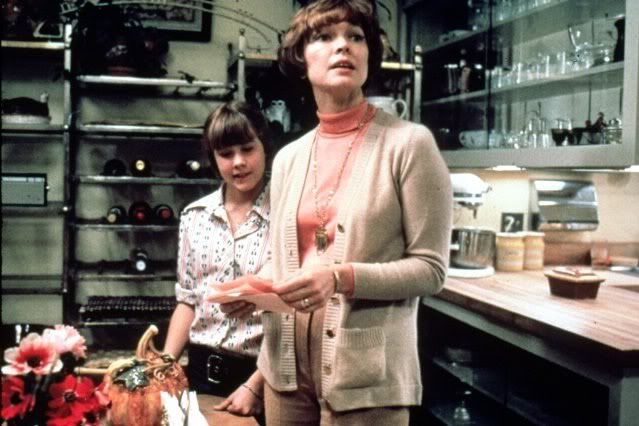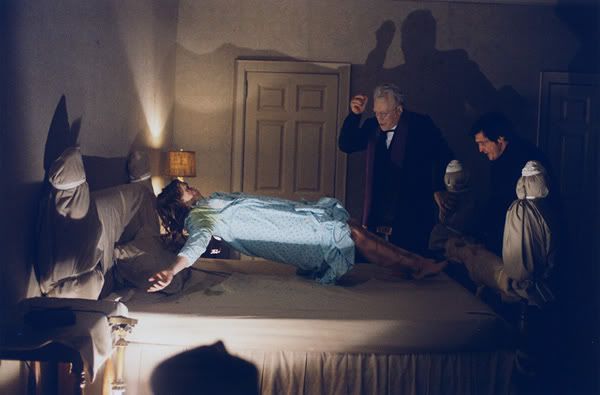 |
| Fig. 1 The Exorcist poster. |
On the surface,
The Exorcist is a supernatural horror film that arrived in cinemas at a time when the genre was only just becoming recognised in the industry. There was a plethora of traditional horror films that came before that were mediocre at best, but
The Exorcist challenged that
. It is a highly thrilling film that still scares and disgusts the audience successfully, despite it being almost forty years old. As Steven Schneider explains that
"The mordant reality of the horror film is never merely dark, but always dark and stormy. Regan...is not just possessed: her head spins 360 degrees, she vomits gallons, and we hear the piss hit the floor as the Devil’s work begins." (Schneider, 2004:153) This shows that the film contains many of the traditional techniques seen in horror films. The visceral imagery of urine and contorting bodies as the young girl falls deeper under the control of the demon possessing her are all associated with the horrific themes contained in movies from this genre. Part of a horror film's appeal is its ability to contain scenes that ordinarily would be considered criminal or inhumane to witness, but due to it's fictional setting the audience can be thrilled by the graphic imagery without there being any kind of consequences. These 'dark and stormy' activities allow the audience to be disgusted and entertained without being judged.
 |
| Fig. 2 Mother and daughter. |
Although it contains many of the themes seen in the usual horror film, it is not the visceral imagery that makes it so unpleasant to watch. Granted, the images are powerful, but it is the reality of the suffering that the audience witnesses between mother and daughter that really makes the film upsetting. Richard Nowell supports this, as he explains that "The Exorcist, which, despite its title, had dealt predominantly with the turbulent relationship of a lone mother (Ellen Burstyn) and her adolescent daughter (Linda Blair)." (Nowell, 2010:86). Despite its conventional horror genre visuals, it's the most realistic situations that are the most unpleasant. One example is when the daughter undergoes a series of scientific tests to make sure she is not suffering from a physical or mental problem. She goes through slow and painful examinations that her mother can only watch. The emotional suffering between the two is upsetting to see, the mothers complete inability to help her child because they both have no idea what could be happening. This relationship, however powerful, is easily overlooked by more visceral physical suffering that surrounds them.
 |
| Fig. 3 The priests exorcise Regan. |
Despite this under-acknowledgement of the mother and daughters 'turbulent relationship' Linda Ruth Williams and Michael Hammond have made an equally important observation from their experience of the film. They expressed that can be interpreted as "both a meditation on the potency of youth protest (the possessed little girl Regan as emblematic of her gender and age group) and a celebration of reactionary controlling forces (the triumph of the priesthood as substitute father figures)." (Williams, Hammond, 2006:121). This can be seen as interpreting the child's possession as a physical mannefestation of puberty and the cultural significance that surrounds that time. During this period, the teenagers, females more specifically, were trying to gain a level of independence. This is also during the time when the second wave of feminism started being noticed, and women were starting to win the rights to have control over their own bodies. These 'controlling forces' represented as 'substitute father figures' can be interpreted as the male government trying to exorcise the wilder aspects of Regan's development into a woman, if you can consider the possession as a manifestation of the fear associated with women's liberation.
List of Illustrations
Figure 1. The Exorcist poster. At:
http://fc06.deviantart.net/fs70/f/2010/269/f/a/the_exorcist_poster_by_markwelser-d2yfext.jpg
Figure . mum and daughter At:
http://www.imdb.com/media/rm4293560064/tt0070047
Figure . Bed scene. At:
http://yesteryearremembered.com/wp-content/uploads/2011/02/exorcist-photo-regan-rising.jpg
Bibliography
Nowell, Richard (2010)
Blood Money : A History of the First Teen Slasher Film Cycle. USA: Continuum International Publishing.
Schneider, Steven (Editor); Andrew, Dudley (Contribution by); Rothman, William (Contribution by).
Horror Film and Psychoanalysis : Freud's Worst Nightmare. USA: Cambridge University Press.
Williams, Linda Ruth; Hammond, Michael (2006)
Contemporary American Cinema. GBR: McGraw-Hill.





No comments:
Post a Comment